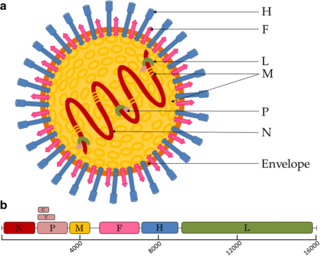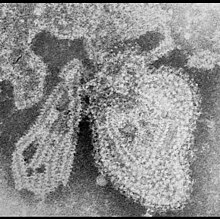
Paramyxoviridae is a family of negative-strand RNA viruses in the order Mononegavirales. Vertebrates serve as natural hosts. Diseases associated with this family include measles, mumps, and respiratory tract infections. The family has four subfamilies, 17 genera, and 78 species, three genera of which are unassigned to a subfamily.

Morbillivirus is a genus of viruses in the order Mononegavirales, in the family Paramyxoviridae. Humans, dogs, cats, cattle, seals, and cetaceans serve as natural hosts. This genus includes seven species. Diseases in humans associated with viruses classified in this genus include measles; in animals, they include acute febrile respiratory tract infection. In 2013, a wave of increased death among the Common bottlenose dolphin population was attributed to morbillivirus.

The mumps virus (MuV) is the virus that causes mumps. MuV contains a single-stranded, negative-sense genome made of ribonucleic acid (RNA). Its genome is about 15,000 nucleotides in length and contains seven genes that encode nine proteins. The genome is encased by a capsid that is in turn surrounded by a viral envelope. MuV particles, called virions, are pleomorphic in shape and vary in size from 100 to 600 nanometers in diameter. One serotype and twelve genotypes that vary in their geographic distribution are recognized. Humans are the only natural host of the mumps virus.

Barnaviridae is a family of non-enveloped, positive-strand RNA viruses. Cultivated mushrooms serve as natural hosts. The family has one genus, Barnavirus, which contains one species: Mushroom bacilliform virus. Diseases associated with this family includes La France disease.

Comovirinae is a subfamily of viruses in the order Picornavirales, in the family Secoviridae; its genera were formerly classified in the family Comoviridae. Plants serve as natural hosts. There are 62 species in this subfamily, assigned to 3 genera.
Teschovirus is a genus of viruses in the order Picornavirales, in the family Picornaviridae. Pigs serve as natural hosts. There are two species in this genus, including Teschovirus A, which is responsible for the porcine enteroviral encephalomyelitis disease caused in pigs. The genus name comes from this species and the disease it causes: Teschen disease, which itself was named for the town Teschen in Poland/Czechoslovakia where the disease was first recognised in 1929.
Entomopoxvirinae is a subfamily of viruses, in the family Poxviridae. Insects, human, vertebrates, and arthropods serve as natural hosts. There are currently 31 species in this subfamily, divided among 4 genera with one species unassigned to a genus. Diseases associated with this subfamily include: impairment of motility and development.

Seadornavirus is a genus of viruses, in the family Reoviridae, in the subfamily Sedoreovirinae. Human, cattle, pig, and mosquitoes serve as natural hosts. There are three species in this genus: Banna virus (BAV), Kadipiro virus and Liao ning virus. Each of these viruses has been isolated from Aedes, Anopheles and Culex mosquito populations, but only BAV has been shown to cause infection in humans, in which the symptoms are similar to Japanese encephalitis—fever, malaise and encephalitis. The word seadornavirus is an portmanteau, meaning Southeast Asian dodeca RNA virus.
Fabavirus is a genus of plant viruses in the order Picornavirales, in the family Secoviridae, in the subfamily Comovirinae. Plants serve as natural hosts. There are seven species in this genus.

Aquareovirus is a genus of double-stranded RNA viruses in the family Reoviridae and subfamily Spinareovirinae. Fish, shellfish, and crustacean species serve as natural hosts. Aquareoviruses in general have low or no pathogenicity for fish. However, some cause hemorrhagic disease, hepatitis and pancreatitis. Grass carp hemorrhage virus is the most pathogenic aquareovirus. There are seven species in this genus.
Idnoreovirus is a genus of double-stranded RNA viruses in the family Reoviridae and subfamily Spinareovirinae. Hymenoptera insects serve as natural hosts. The genus name is an acronym for insect derived non occluded reovirus. There are five species in this genus.

Respirovirus is a genus of viruses in the order Mononegavirales, in the family Paramyxoviridae. Rodents and human serve as natural hosts. There are seven species in this genus. Diseases associated with this genus include: croup and other acute febrile respiratory tract infections.

Quadriviridae is a family of double-stranded RNA viruses with a single genus Quadrivirus. The fungi Rosellinia necatrix serves as a natural host. The name of the group derives from the quadripartite genome of its members where in Latin quad means four. There is only one species in this family: Rosellinia necatrix quadrivirus 1.
Aquaparamyxovirus is a genus of viruses in the family Paramyxoviridae, order Mononegavirales. The genus includes two species. Fish serve as the natural hosts for AsaPV, in which the virus may cause proliferative gill inflammation.
Ferlavirus is a genus of viruses in the family Paramyxoviridae, order Mononegavirales. Reptiles serve as natural hosts. There is currently only one species in this genus to accommodate a single virus, Fer-de-Lance virus (FDLV).
Mimoreovirus is a genus of viruses, in the family Reoviridae, in the subfamily Sedoreovirinae. The only isolate infects the marine photosynthetic protist Micromonas pusilla, a prasinophyte. There is only one species in this genus: Micromonas pusilla reovirus.
Pasivirus is a genus of viruses in the order Picornavirales, in the family Picornaviridae. Pigs serve as natural hosts. There is only one species in this genus: Pasivirus A.
Perhabdovirus is a genus of viruses in the family Rhabdoviridae, order Mononegavirales. Fish serve as natural hosts. Diseases associated with viruses of this genus include: breathing and swimming problems.
Sapelovirus is a genus of viruses in the order Picornavirales, in the family Picornaviridae. Pig serve as natural hosts. There are two species in this genus.
Bat mumps orthorubulavirus, formerly Bat mumps rubulavirus (BMV), is a member of genus Orthorubulavirus, family Paramyxoviridae, and order Mononegavirales. Paramyxoviridae viruses were first isolated from bats using heminested PCR with degenerate primers. This process was then followed by Sanger sequencing. A specific location of this virus is not known because it was isolated from bats worldwide. Although multiple paramyxoviridae viruses have been isolated worldwide, BMV specifically has not been isolated thus far. However, BMV was detected in African fruit bats, but no infectious form has been isolated to date. It is known that BMV is transmitted through saliva in the respiratory system of bats. While the virus was considered its own species for a few years, phylogenetic analysis has since shown that it is a member of Mumps orthorubulavirus.









